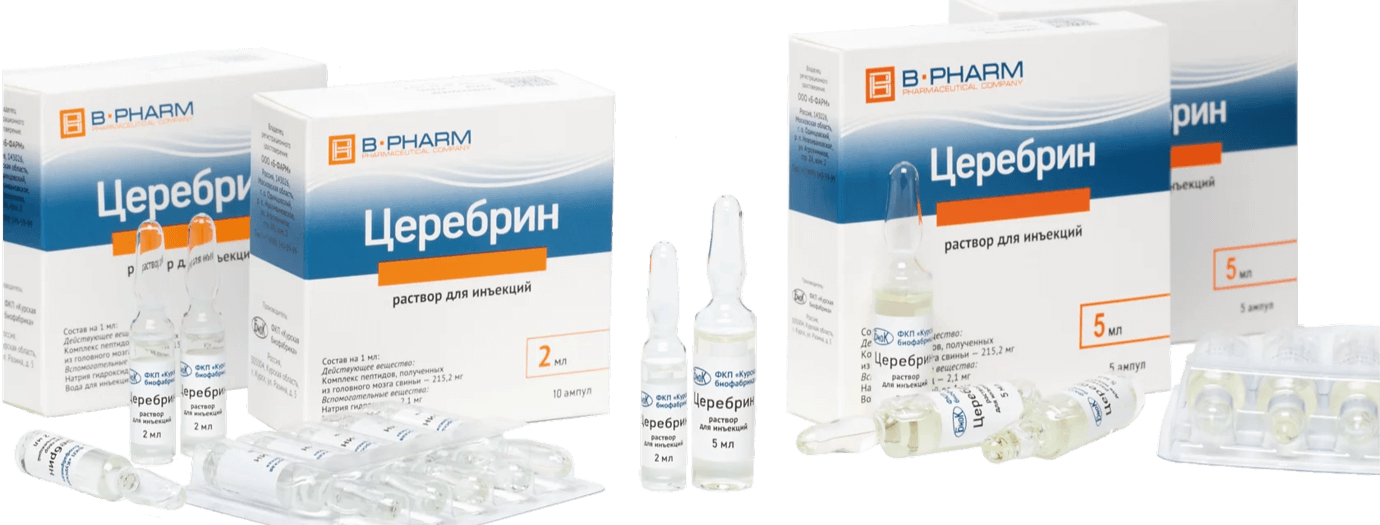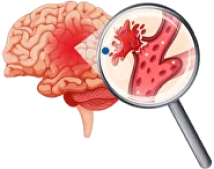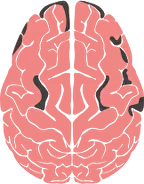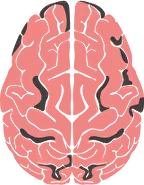Cerebrin neuropeptide drug
Stroke. Dementia. TBI

About the drug
Cerebrin - medical product, pharmacotherapeutic group - nootropic drug
Main
use of the drug - treatment of neurological diseases
Balanced and stable blend of biologically active oligopeptides
Provides
neuroprotectionNeurotrophic activity similar to the natural neuronal growth factors (NGF)
Polyfunctional effect on the brain
Stimulates
neuromodulationPositive effect on intracellular protein synthesis in the developing and aging brain
Cerebrin - benefits
- Ready-to-use dosage form - solution for injection
- Recommended for use in the acute phases of diseases - ischemic stroke, traumatic brain injury, complications of neurosurgical operations
- The high drug safety and tolerability are confirmed by many years of experience
- All routes of parenteral administration are available - intramuscularly, intravenously, in the form of infusions
- Suitable for all ages
- Included in the list of Vital and Essential Drugs, list of subsidized drugs, available for prescription under the state guarantees program
- Complies with clinical guidelines of the Ministry of Health of the Russian Federation
- Included in the standards of medical care for approved indications
Application instructions:
- Ischemic stroke
- Traumatic injuries of the brain and spinal cord
- Chronic cerebrovascular insufficiency
- Mental retardation in children
- Attention deficit and hyperactivity in children
- Dementia syndrome of various genesis
- Alzheimer's disease
- In complex therapy for endogenous depression resistant to antidepressants
cerebrin
neuropeptide drugComposition per 1 ml:
- Active ingredients: Complex of peptides derived from pig brain 215,2 mg
- Excipients: Sodium hydroxide 2,1 mg, water for injection up to 1 ml
method of administration and dosage
Application:
Intramuscularly (up to 5 ml)
Intravenously (up to 10 ml)
Infusion (from 10 to 50 ml)
Treatment course 10-20 days
Acute conditions (ischemic stroke, craniocerebral trauma, complications of of neurosurgical operations):
From 10 ml to 50 mlIn the residual period of cerebral stroke and traumatic brain and spinal cord injury:
From 5 ml to 50 mlIn psycho-organic syndrome and depression:
From 5 ml to 30 mlIn Alzheimer's disease, dementia of vascular and combined Alzheimer's-vascular genesis:
From 5 ml to 30 mlIn neuropediatric practice:
0,1-0,2 ml/mg body weight
Composition of Cerebrin
Balanced and stable blend of biologically active oligopeptides
Total polyfunctional action
The drug Cerebrin contains low molecular weight biologically active neuropeptides that penetrate the blood-brain barrier and directly enter the nerve cells.
Oligopeptides are called peptides that have no more than 10 amino acids in the structure of their chain. The complex composition of Cerebrin includes a wide range of amino acids. In the production and quality control of the finished medicinal product, the amount of amino acids is strictly standardized.
Each of the constituent amino acids of Cerebrin is found in all organisms in its free form and as part of oligopeptides. In addition, they act as neurotransmitters in the central nervous system.
For the neurotrophic and neuroprotective roles of the individual amino acids that make up Cerebrin, see the tab below.
Ischemic stroke
MAIN TYPES OF STROKE

Hemorrhage in the brain

Blood enters the brain tissue due to rupture of the vessel or seeps through its walls
Area of the brain without blood supply

Blood flow blocked by an atherosclerotic plaque, thrombus, or other cause
- Ischemic stroke - is a clinical syndrome manifested by an acute disturbance of local brain functions that lasts more than 24 hours, or leads to death, can be caused either by insufficient blood supply to a certain area of the brain as a result of a decrease in cerebral blood flow, thrombosis or embolism associated with diseases of the vessels, heart or blood
- Every year, 0.2% of the world's population develops a stroke, as well as 1% of those over 65
- Mortality after a first-ever stroke is 12% within the first 7 days, 19% within the first 30 days, 31% within a year, and 60% within 5 years after a stroke
- Ischemic stroke is the second leading cause of death in the world and the third leading cause of disability adjusted for life years
Share of deaths from stroke in total number of deaths (Russia)

Traumatic brain injury
It is recommended that medication be administered during all periods of treatment, recovery, and rehabilitation for traumatic brain and spinalcord injuries
Consequences of TBI
- Tissue
- Liquorodynamic
- Vascular
- Other
Сomplications of TBI
- Neurotrophic
- Iatrogenic
- Immune
- Pyoinflammatory
- Othere
Traumatic brain injury as a cause of death ranks first among people between the ages of 20 and 40, so the problem is not only medical but also social
The most common
causes of TBI

Сhronic cerebrovascular insufficiency
Chronic cerebrovascular insufficiency is one of the most common pathologies of the nervous system.
This disease has many names:
dyscirculatory encephalopathy, chronic
cerebral ischemia, vascular, atherosclerotic, hypertensive, atherosclerotic angioencephalopathy,
vascular (atherosclerotic) parkinsonism, vascular (late) epilepsy, vascular dementia.
Cerebrovascular disease is a pathological change in the vessels of the brain, provoking a violation of the circulation of cerebral blood flow.
Pathology is preceded by atherosclerosis and hypertension, and its consequence is a stroke with disability or death.
Cerebrovascular pathology is divided into acute and chronic forms
Acute types of cerebrovascular disease
- acute encephalopathy of hypertensive type
- transient ischemic attack
- hemorrhagic / ischemic stroke
Chronic form of cerebrovascular discircular encephalopathy
- dyscircular encephalopathy
Childrens attention deficit and hyperactivity
Attention deficit and/or hyperactivity disorder (ADHD) is a neurological-behavioral developmental disorder that occurs in childhood
With this disorder, the functioning of the central nervous system (mainly in the area of the reticular formation of the brain) is disrupted, which leads to difficulties with concentration and maintenance of attention, impaired memory and learning ability, as well as difficulties in processing information.

Main reason
- Rapidly developing in prenatal ontogenesis (intrauterine development) primary organic defects in the functional systems of the brain stem
Effects
- Weakened control of the brainstem reticular formation over the thalamic nonspecific structures, which play a major role in coordinating the functioning between different parts of the brain that take part in memory formation and ensure the preservation of intelligence in the ADHD patient
Dementia
Dementia is a syndrome that occurs when the brain is damaged and is characterized by impairments in the cognitive sphere (perception, attention, recognition, memory, intelligence, speech, ability to perform purposeful actions).
About 50 million people in the world suffer from dementia
- Among the population over 65 years of age, dementia of varying severity occurs in approximately 20% of people (5% in the population - severe dementia)
- Due to the aging of the population, especially in developed countries, the issues of diagnosis, treatment and prevention of dementia are extremely acute social problems
- The mild stage of dementia is often not recognized, confusing it with depression, fatigue. This is the difficulty of diagnosing the early stage of dementia
- In addition to care, patients need medical treatment for their favorable condition
Classification
Four types of dementia are distinguished based on the predominant involvement of certain parts of the brain:
![Cortical dementia]()
Cortical dementia
The cerebral cortex suffers predominantly. Observed in alcoholism, Alzheimer's disease and Pick's disease (frontotemporal dementia)
![Subcortical dementiaя]()
Subcortical dementia
Subcortical structures are affected. It is accompanied by neurological disorders (limb tremor, muscle stiffness, gait disturbances, etc.). It occurs in Parkinson's disease, Huntington's disease, and white matter injury
![Cortical-subcortical dementia]()
Cortical-subcortical dementia
Mixed type of lesion, characteristic of the pathology caused by vascular disorders
![Multifocal dementia]()
Multifocal dementia
Pathology characterized by multiple lesions in all parts of the central nervous system
SEVERITY OF DEMENTIA
Light
Although work and social activities are significantly impaired, the ability to live independently is preserved, with the observance of the rules of personal hygiene and the relative preservation of criticism
Moderate
It is risky to leave the patient, and some supervision is required
Severe
Daily activities are impaired, constant supervision is required (for example, the patient is not able to follow the rules of personal hygiene, does not understand what is being said to him, and does not speak)
Alzheimer's disease
MAIN TYPES OF DEMENTIA

EPIDEMIOLOGY
Neurodegenerative dementia
- Alzheimer's disease
- Lewy body dementia
- Frontotemporal degeneration
Vascular dementia
- cerebrovascular diseases
Mixed dementia
- vascular degenerative
- Alzheimer's disease
+ Cerebrovascular diseases
Antidepressant resistant endogenous depression
Depression is a mental disorder, the main features of which are low - depressed, melancholy, anxious, fearful or indifferent - mood and a decrease or loss of the ability to enjoy (anhedonia)
The high prevalence and severity of the medical and social consequences of depression in the form of chronicity, recurrence, resistance, disorders of social functioning, quality of life and suicidal behavior raise the problem to the rank of the most urgent, requiring study in terms of early diagnosis and optimization of psychosis therapy
It has been established that the associated depression worsens the prognosis of somatic and neurological diseases, increasing the mortality rates, the severity of the disease and the development of complications





